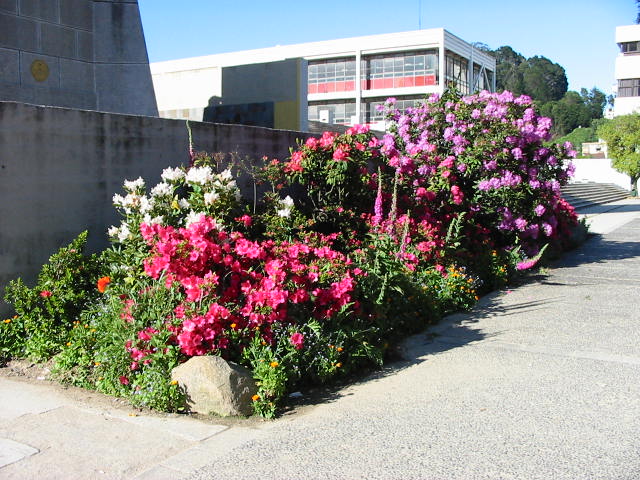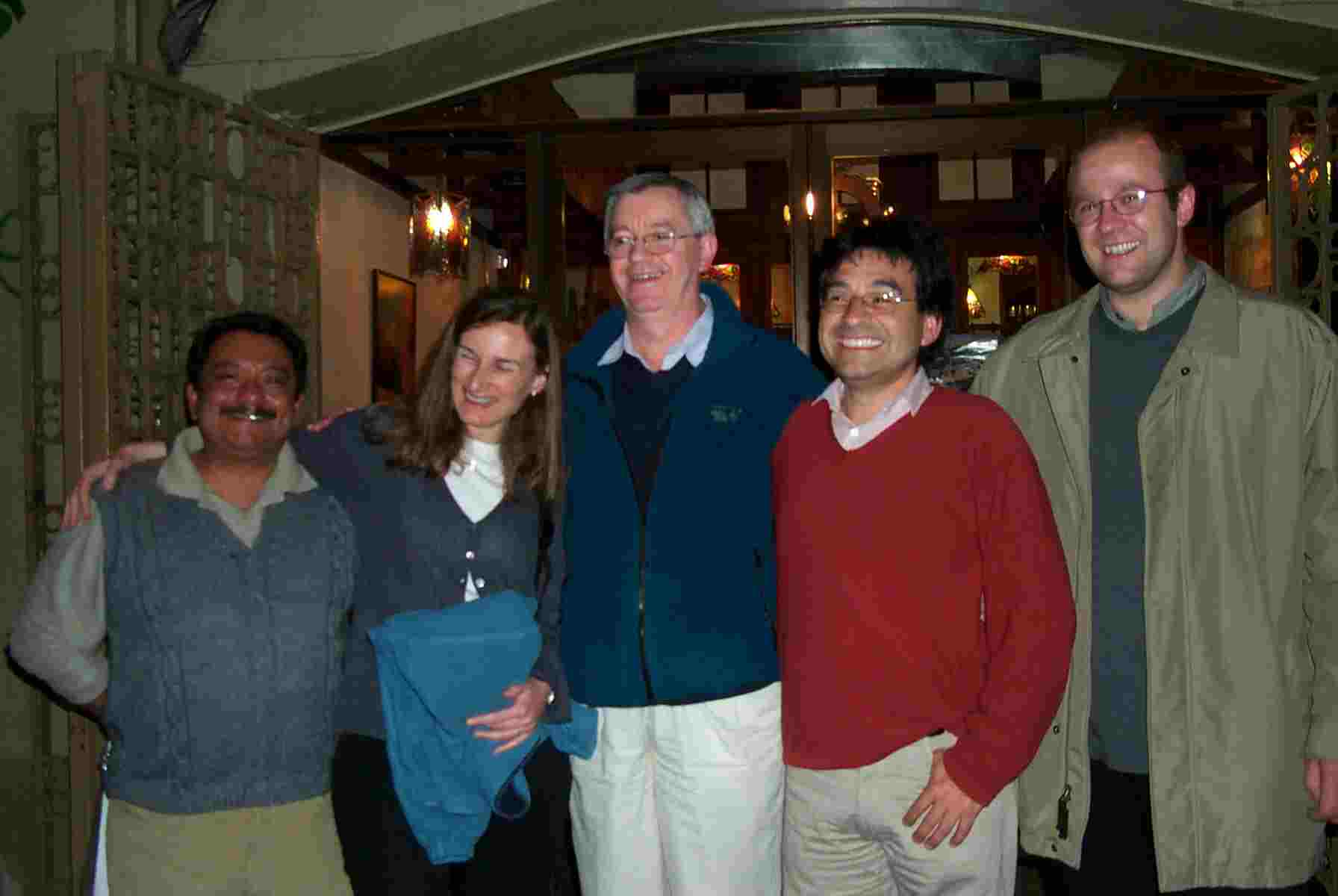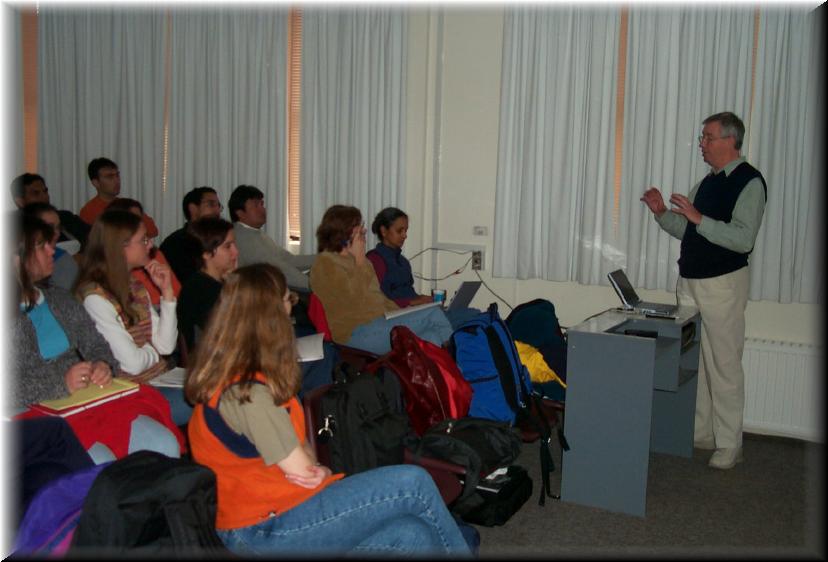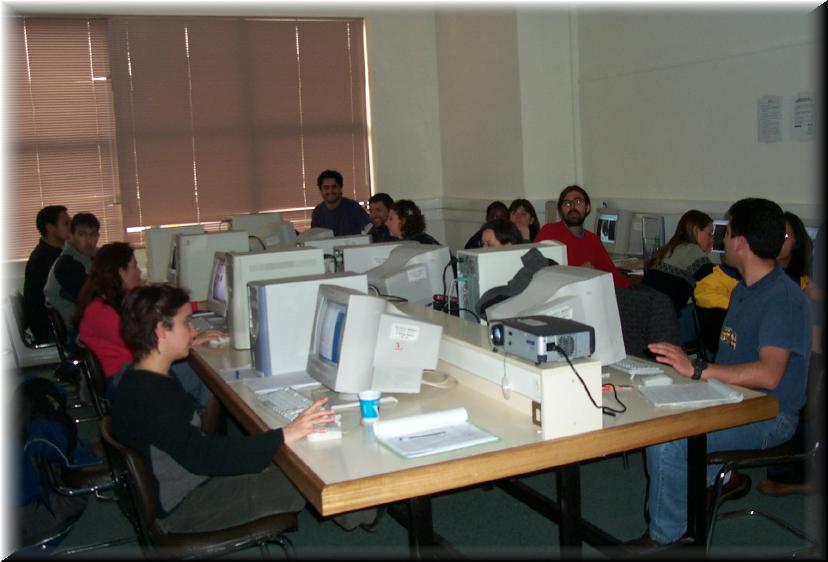Report on Primary Production Training Course
University of Concepción, Chile21 October - 1 November, 2002
by Dr. Trevor Platt
Bedford Institute of
Oceanography, Dartmouth, Nova Scotia Canada
 An advanced course on "Primary Production: Theory, Modelling and
Estimation by Remote Sensing" was held from October 21 to 1 November,
2002 at the University of Concepción (UdeC), Chile. It was held under the
auspices of IOC/UNESCO, the Chilean Ministry of Education (MECESUP), Minera
Escondida, the DAAD, the UdeC's School of Graduate Studies and the Center
for Oceanographic Research (COPAS), with additional funding from the
International Ocean-Colour Coordinating Group (IOCCG) and from the
Partnership for Observation of the Global Ocean (POGO) to facilitate
participation by students from outside Chile. In all there were 26
students, of whom 8 were from Chile and 18 from elsewhere (7 other
countries). See list of students attending
the training course.
An advanced course on "Primary Production: Theory, Modelling and
Estimation by Remote Sensing" was held from October 21 to 1 November,
2002 at the University of Concepción (UdeC), Chile. It was held under the
auspices of IOC/UNESCO, the Chilean Ministry of Education (MECESUP), Minera
Escondida, the DAAD, the UdeC's School of Graduate Studies and the Center
for Oceanographic Research (COPAS), with additional funding from the
International Ocean-Colour Coordinating Group (IOCCG) and from the
Partnership for Observation of the Global Ocean (POGO) to facilitate
participation by students from outside Chile. In all there were 26
students, of whom 8 were from Chile and 18 from elsewhere (7 other
countries). See list of students attending
the training course.
The additional funding from international committees also allowed the
participation of more instructors than would otherwise have been the case.
 The list of instructors was: Dr. Trevor Platt (Bedford
Institute of Oceanography, Canada); Dr. Shubha Sathyendranath, (Dalhousie
University, Canada); Dr. Vivian Lutz (Instituto Nacional de Investigación y
Desarrollo Pesquero, Argentina); Dr. Cesar Fuentes-Yaco (Bedford Institute
of Oceanography, Canada); Dr. Mark Dowell (University of New Hampshire,
USA); and Dr. Osvaldo Ulloa (University of Concepcion, Chile). In addition,
Mr. Gabriel Yuras provided assistance in the practical demonstrations.
The list of instructors was: Dr. Trevor Platt (Bedford
Institute of Oceanography, Canada); Dr. Shubha Sathyendranath, (Dalhousie
University, Canada); Dr. Vivian Lutz (Instituto Nacional de Investigación y
Desarrollo Pesquero, Argentina); Dr. Cesar Fuentes-Yaco (Bedford Institute
of Oceanography, Canada); Dr. Mark Dowell (University of New Hampshire,
USA); and Dr. Osvaldo Ulloa (University of Concepcion, Chile). In addition,
Mr. Gabriel Yuras provided assistance in the practical demonstrations.
Some of the instructors at the training course: Drs. Cesar Fuentes-Yaco, Vivian Lutz, Trevor Platt, Osvaldo Ulloa and Mark Dowell
The course proceeded by lectures in the morning and by practical work in the computing laboratory in the afternoons. In addition students were encouraged to give short presentations on their own work, and most of them did so.
In the practical sessions, the students learned to use the software MATLAB,
which is important in the image analysis field (and indeed in many other
fields of science). Next, they learned to acquire and process ocean-colour
data for regions of their interest.  Then, they learned to apply MATLAB to the calculation of the submarine
light field and of primary production. Finally, they processed an
ocean-colour image from a region of their choice and used it to estimate
primary production for the region concerned.
Then, they learned to apply MATLAB to the calculation of the submarine
light field and of primary production. Finally, they processed an
ocean-colour image from a region of their choice and used it to estimate
primary production for the region concerned.
Many students took the course for credit, and an evaluation was therefore required. This took the form of a small research proposal. The students were required to state the objectives of the proposed research, the area of study, methods, and expected results. The context was an ocean-colour image that they had processed themselves and that they were required to interpret as part of the exercise. The proposal would illustrate an application of ocean-colour data according to the interests of the student.
The lectures covered the following material:
- Introduction to primary production;
- Survey of ocean-colour science;
- Photosynthetic response of phytoplankton to available light;
- Computation of primary production at discrete depths;
- Computation of daily, watercolumn primary production (non-spectral, uniform biomass);
- Introduction to marine optics;
- The photosynthetic apparatus;
- Optical properties of seawater and constituents;
- Phytoplankton pigments and their absorption properties;
- Spectral and non spectral models of photosynthesis;
- Fluorescence of phytoplankton;
- Ocean-colour algorithms for Case-1 seawater;
- Implications of fluorescence for remote sensing;
- Dimensional analysis of primary production and reference horizons in the water column;
- Bio-optical variability, a case-study for Argentinian waters;
- Computation of watercolumn primary production in stratified water using a spectral model;
- Operational ocean colour in the Atlantic Zone of Canada;
- Ocean colour algorithms for case-2 waters;
- Development and validation of regional algorithms for biomass retrieval;
- Matching in situ and remotely-sensed data, time and space scales;
- Extrapolation protocols for use with remotely-sensed data;
- Fisheries applications of ocean colour;
- Impact of hurricane passage on phytoplankton as seen by ocean colour.
At the end of the course, the students were presented with a CD containing material from the course, including software, manuals and lecture notes in 30 chapters (some 234 pages). In addition, a website was established containing all this material and other logistic information relevant to the course. This website will continue to be available after the course is finished, for the benefit of the students. It will be protected by password and will include, for example, the projects submitted by them for the evaluation.
Various factors contributed to the undoubted success of this course. First
was the selection of the participants: several really outstanding students
were identified, and the average level of ability was very high. The
extent of their motivation was most impressive. Second, the facilities
provided by the university were excellent.  A very fine computing laboratory, located adjacent to the
lecture room, was provided for exclusive use every afternoon, and all day
on weekends. This allowed the students to work individually or in pairs on
their image analyses and facilitated practical demonstrations. Third, the
magnificent support rendered by Mr. Gabriel Yuras ensured that the
practical part of the course ran without difficulty.
A very fine computing laboratory, located adjacent to the
lecture room, was provided for exclusive use every afternoon, and all day
on weekends. This allowed the students to work individually or in pairs on
their image analyses and facilitated practical demonstrations. Third, the
magnificent support rendered by Mr. Gabriel Yuras ensured that the
practical part of the course ran without difficulty.
Given all these favourable circumstances, the instructors were able to
achieve everything they had intended to do. The additional financial
support provided by the IOCCG and by POGO leveraged the Chilean funds to
the maximum and enabled students from outside Chile to attend, and
additional instructors to contribute, to the benefit of all concerned. The
contacts developed between students and instructors, and between the
students themselves, should be invaluable in the future. It is expected
that they will lead to development of a multilateral joint research
proposal in the subject area of the course.
 Students
attending the Primary Production training course at the University of
Concepcion
Students
attending the Primary Production training course at the University of
Concepcion